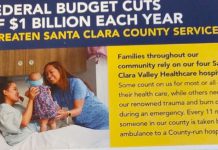The price tag and construction timeline for California’s high-speed rail project increased significantly Tuesday, as officials unveiled what they call a “realistic” business plan for the state’s controversial and expensive transit endeavor.
Costs for the 800-mile rail line have jumped to $98.5 billion – nearly three times initial estimates, and the entire project won’t be up and running until 2033 – nine years later than previously projected, according to the plan. California High-Speed Rail Authority officials also said they have enough cash on hand – $16 billion – to build the project’s first leg, but after that, the updated plan will bank on private contributions and state and federal funding sources, some of which currently don’t exist.
Dan Richard, a Rail Authority board member who helped draft the plan, called it “a departure of past efforts of the Authority” during a press conference at the California State Railroad Museum in Sacramento. Residents will have 60 days to comment on the plan, which drew little support and “I-told-you-so” responses from several South County officials.
“I’ve been questioning the cost estimates from Day 1,” said Mike Wasserman, Santa Clara County District 1 supervisor. “Does it surprise me? No. Does it worry me? Yes.”
Voters passed Proposition 1A in 2008, which approved a series of general obligation funds to partially support what was then advertised as a roughly $33-billion project. But since then, criticism for the project has grown as cost predictions have spiked.
“Please, drive a stake through its heart,” Gilroy City Councilman Bob Dillon laughed after hearing details of the new plan. “It’s not surprising. I still oppose it.”
Protesting at this point probably won’t do much good, and city officials – some begrudgingly – will just have to grit their teeth and participate, Dillon said.
“We’ll probably have to deal with it. As much as I hate the entire idea and think it’s a giant boondoggle, we’ll have to be in on the planning,” he said.
When told the project likely wouldn’t be finished for roughly two decades, Dillon, 64, said, “Wonderful, I’ll be dead.”
Roughly 80 to 85 percent of the cost increases come from construction delays and new additions to proposed alignments – including bridges, trenches and underpasses suggested by local officials and residents statewide – while the remainder is based on increases in the costs of construction materials. The plan also assumes a 3 percent inflation rate for the next 20 years, and the new nine-year delays factors in predictable halts and restarts over the course of the project, including probable funding issues, according to Rail Authority board member Mike Rossi.
Gilroy Councilman Perry Woodward called the new plan “much more realistic,” but imagined costs would climb even higher and construction estimates would be pushed back further still.
“This is just a belated recognition of the obvious,” Woodward said of the plan. “This really raises the question: Will it be built at all? Is this something that people of the state of California want? My suspicion is, my belief is, if it gets built at all, it won’t be until well after 2033.”
While Rail Authority board chair Tom Umberg says he believes Californians still strongly support the project, Woodward disagrees.
“No. We know for a fact, it’s only now a small percentage. Now that people have learned what this means,” he said. “The polls show this is not a popular idea any longer.”
A recent survey appears to support Woodward’s comments. A public opinion poll released Sept. 28 by Newport Beach, Calif., based Probolsky Research LLC revealed 62 percent of 750 state registered voters surveyed would vote to stop the project, and one-third said they would use the train to travel between San Francisco and Los Angeles. The surveys were completed via telephone over a five-day span.
Democratic Congressman Sam Farr – whose 17th district will now include Gilroy – said he still supported the project despite the increased costs.
“It would be a great asset once it’s built. Some of us have to be futurists,” Farr said. “How we can build the future of tomorrow?”
The project is expected to take riders between Los Angeles to San Francisco in 2 hours, 40 minutes, according to projections. The plan includes a station in Gilroy.
Officials said they have enough money – $16 billion – to begin the project by building its first segment: up to 140 miles in the San Joaquin Valley between Bakersfield and Fresno, infamously referred to by critics as the “train to nowhere.” Construction on that initial portion is set to begin in 2012.
The initial phase should create “hundreds of thousands of jobs” alone, Rail Authority board member Richard said.
After the first leg, officials said they’ll have to decide whether to build south to the Los Angeles basin or northwest to San Jose and the San Francisco Bay Area.
While the Rail Authority doesn’t yet have the money to continue construction following the first section, rail officials say they aren’t fretting, even despite projections the project could lose $2-3 billion each additional year it’s delayed.
“We have three years before we need to start worrying about getting that funding,” Rail Authority board member Rossi said.
Later during the press conference – to which the Dispatch listened via a conference call – Rail Authority Chair Umberg said, “the private sector has expressed interest” in offering funding but gave no further details. When asked if the Rail Authority would be able to finance the project past San Joaquin Valley phase, he said, “There’s always challenges.”
“Right now, we’re fine, with respect to the initial construction,” Umberg said.
It will be approximately 18 months before rail officials cement which route to take following the San Joaquin Valley line, officials said. Which direction the project follows could determine how much riders will pay to use the system, according to the plan.
One-way fares will range between $39 and $123 – depending on where riders are traveling, when they buy tickets, departure times and how many stops are expected. A ride from San Francisco to Los Angeles during off-peak hours ($52) comes in at far less than the same trek purchased last-minute or on an express train ($123).
Riders, on average, will fork over $81 to ride from San Jose to Anaheim, according to the plan.
The plan also uses three separate models – low, medium and high – to project ridership figures. Over that range, the plan projects between 29.6 million and 43.9 million riders by the year 2040.
Citizens group Californians Advocating Responsible Rail Design remains critical of the Rail Authority’s model for projecting ridership, said Nadia Naik, the group’s co-founder. Tuesday’s new costs also were more than $30 billion above CARRD’s “conservative” estimate released in February, Naik said.
There was no specific information in the 230-page plan in terms of fares or ridership regarding a station in Gilroy.
The Garlic Capital itself, though, has already been in the thick of recent high-speed rail history.
The city is finishing up a $200,000 rail station Visioning Project – reimbursed through Valley Transportation Authority grant money – which lets residents forecast the future of areas immediately surrounding two station location options: downtown and east of U.S. Highway 101 in prime agricultural land.
In November 2010, Rail Authority CEO Roelof van Ark visited Mayor Al Pinheiro and other city officials after the City Council voted 4-3 one month earlier to send a “vote of no confidence” to high-speed rail officials. Council members Cat Tucker, Dion Bracco, Craig Gartman and Dillon voted in favor of the resolution, while Woodward, Peter Arellano, and Pinheiro were against it.
The CEO visited City Hall again this past January, in a meeting both sides said was needed to revamp foundering communication between rail officials and the Garlic Capital.
Dialogue between state and local officials will be paramount as the project goes forward, said Jim Hartnett, former Redwood City mayor who helped develop the new plan, during the press conference.
“We have to listen to our communities, we have to listen to our local and regional transit partners.”
Hartnett even invoked baseball legend and quote machine Yogi Berra to describe the Rail Authority’s direction.
“When you a reach a fork in the road, take it,” he said. “And I think that’s where we are now.”
Richard stressed patience during the project, saying the goal was to finish the system “over a generation. Not just in the next few years.” He said the plan also reveals the authority’s new philosophy, saying the project “will not be a separate, insular, stand-alone system,” but part of a fabric of rail systems statewide. The high-speed rail line will connect to existing systems including Caltrain in the Bay Area and Metrolink in the Los Angeles region, he said.
“High-speed rail will be hard to do and hard to accomplish,” Richard said, “But it’s worth it for the citizens of California.”












